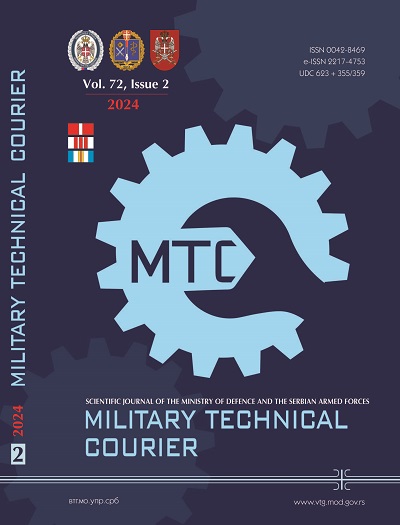Methodology of training members of river units on a ship simulator
Abstract
Introduction/aim: This paper aims to present the methodology for creating educational content/scenarios on a ship simulator (bridge simulator) that will serve officers of river units in developing the ability to react when performing regular and military tactical tasks on the ships of the River Flotilla. Also, training on the simulator aims to train officers of river units using modern information technologies.
Methods: The paper uses simulation methods, experimental methods, case studies, and operational research.
Results: Specific educational content/scenarios were created, also specific methodology was developed and the principles were clearly defined according to which content/scenarios are created on the ship simulator.
Conclusion: By using the ship simulator, in different teaching scenarios, cadets of river units as well as members of river units are trained and acquire the ability to react adequately in real situations in the shortest possible time.
References
Ari, I., Aksakalli, V., Aydogdu, V. & Kum, S. 2013. Optimal ship navigation with safety distance and realistic turn constraints. European Journal of Operational Research, 229(3), pp.707-717. Available at: https://doi.org/10.1016/j.ejor.2013.03.022.
Bugarski, V., Kulić, F., Kanović, Ž. & Bačkalić, T. 2020. Fuzzy logic applications in inland waterway transportation. Journal on Processing and Energy in Agriculture, 24(3-4), pp.115-118. Available at: https://doi.org/10.5937/jpea24-30238.
-European Commission. 2018. HORIZON 2020: Promoting Innovation in the Inland Waterways Transport Sector. Brussels, Belgium: European Commission CORDIS EU research results. Available at: https://doi.org/10.3030/633929.
-International Maritime Organization (IMO). 2010. International Convention on Standards of Training, Certification and Watchkeeping for Seafarers (STCW), 1978 (the 2010 Manila amendments). London, UK: IMO-International Maritime Organization [online]. Available at: https://www.imo.org/en/OurWork/HumanElement/Pages/STCW-Convention.aspx [Accessed: 10 October 2023].
-International Maritime Organization (IMO). 2014. SOLAS, consolidated edition 2014: consolidated text of the International Convention for the Safety of Life at Sea, 1974, and its Protocol of 1988: articles, annexes and certificates. ATS Library [online]. Available at: https://atslib.omeka.net/items/show/9157 [Accessed: 10 October 2023].
Kresojevic, M. & Ristic Vakanjac, V. 2023. Ship Maneuvering Using a Ship Simulator in Search and Rescue Operation. In: Li, Y., Hu, Y., Rigo, P., Lefler, F.E. & Zhao, G. (Eds.) Proceedings of PIANC Smart Rivers 2022. PIANC 2022. Lecture Notes in Civil Engineering, 264, pp.969-977, Singapore: Springer. Available at: https://doi.org/10.1007/978-981-19-6138-0_86.
Nikolić, L. 2016. Upotreba brodskog simulatora u osposobljavanju pripadnika roda rečnih jedinica. BA thesis. Belgrade: University of Defence, Military Academy (in Serbian).
Radojević, S. 2013. Sigurnost i bezbednost plovidbe. Belgrade: Media Center „Odbrana“ (in Serbian). ISBN: 978-86-335-0361-7.
Radojević, S. & Kresojević, M. 2020. Saving Migrants From The Sea: Improving Training For Search And Rescue Operations. TransNav International Journal on Marine Navigation and Safety of Sea Transportation, 14(1), pp.129-133. Available at: https://doi.org/10.12716/1001.14.01.15.
Rosić, S. 2010. Plovidba unutrašnjim plovnim putevima. Belgrade: Media Center „Odbrana“ (in Serbian). ISBN: 978-86-335-0303-7.
Sellberg, C. 2018. From briefing, through scenario, to debriefing: the maritime instructor's work during simulator-based training. Cognition, Technology & Work, 20, pp.49-62. Available at: https://doi.org/10.1007/s10111-017-0446-y.
Sharma, A., Nazir, S., Wiig, A.C., Sellberg, C., Imset, M. & Mallam, S. 2018. Computer supported collaborative learning as an intervention for maritime education and training. In: Nazir, S., Teperi, A.M. & Polak-Sopińska, A. (Eds.) Advances in Human Factors in Training, Education, and Learning Sciences. AHFE 2018. Advances in Intelligent Systems and Computing, vol 785, Orlando, FL, USA, pp.3-12, July 21-25. Cham: Springer. Available at: https://doi.org/10.1007/978-3-319-93882-0_1.
-Službeni glasnik Republike Srbije. 111/2020. Uredba o dopuni uredbe o uslovima za plovidbu i pravilima plovidbe na unutrašnjim vodama. Belgrade: JP „Službeni glasnik“ (in Serbian) [online]. Available at: https://www.paragraf.rs/glasila/rs/sluzbeni-glasnik-republike-srbije-111-2020.html [Accessed: 10 October 2023].
Šoškić, S., Ćurčić, J. & Radojević, S. 2011. Implementation of the STCW Convention at the Serbian Military Academy. In: Weintrit, A. & Neumann, T. (Eds) Human Resources and Crew Resource Management: Marine Navigation and Safety of Sea Transportation, 1st Edition. London: CRC Press. Available at: https://doi.org/10.4324/9781315266299.
Vlačić, S.I., Knežević, A.Z., Grbović, V.M., Vitsas, P.A. & Mihajlović, M.M.S. 2022. Implementation of the digital training concept in the basic flight training at the Serbian Military Academy. Vojnotehnički glasnik/Military Technical Courier, 70(1), pp.87-108. Available at: https://doi.org/10.5937/vojtehg70-34610.
Zghyer, R. & Ostnes, R. 2019. Opportunities and Challenges in Using Ship-Bridge Simulators in Maritime Research. In: Proceedings of Ergoship 2019, Haugesund, Western Norway University of Applied Sciences (HVL), pp.119-129, September 24-25 [online]. Available at. https://www.hvl.no/contentassets/9d0c2d7885534c1fb21d17d7c474a828/ergoship_2019_proceedings.pdf [Accessed: 10 October 2023].
Copyright (c) 2024 Slobodan M. Radojević, Milan M. Kresojević, Svetislav D. Šoškić, Dejan D. Mihajlović

This work is licensed under a Creative Commons Attribution 4.0 International License.
Proposed Creative Commons Copyright Notices
Proposed Policy for Military Technical Courier (Journals That Offer Open Access)
Authors who publish with this journal agree to the following terms:
Authors retain copyright and grant the journal right of first publication with the work simultaneously licensed under a Creative Commons Attribution License that allows others to share the work with an acknowledgement of the work's authorship and initial publication in this journal.
- Authors are able to enter into separate, additional contractual arrangements for the non-exclusive distribution of the journal's published version of the work (e.g., post it to an institutional repository or publish it in a book), with an acknowledgement of its initial publication in this journal.
- Authors are permitted and encouraged to post their work online (e.g., in institutional repositories or on their website) prior to and during the submission process, as it can lead to productive exchanges, as well as earlier and greater citation of published work (See The Effect of Open Access).

